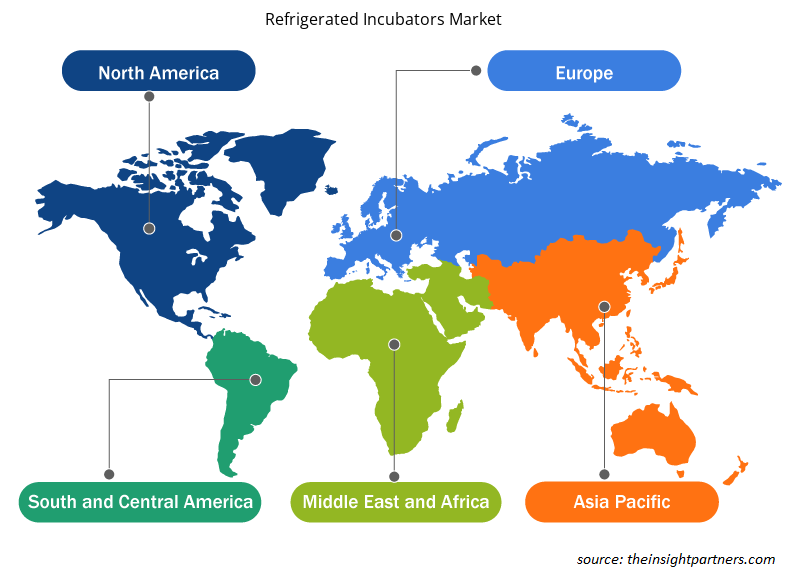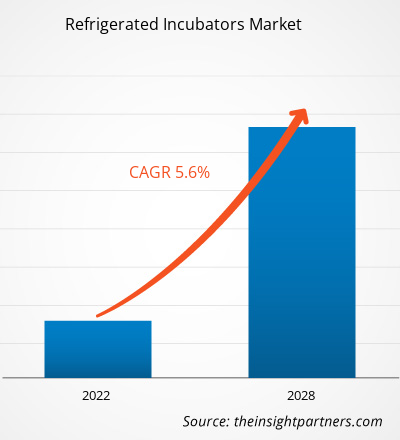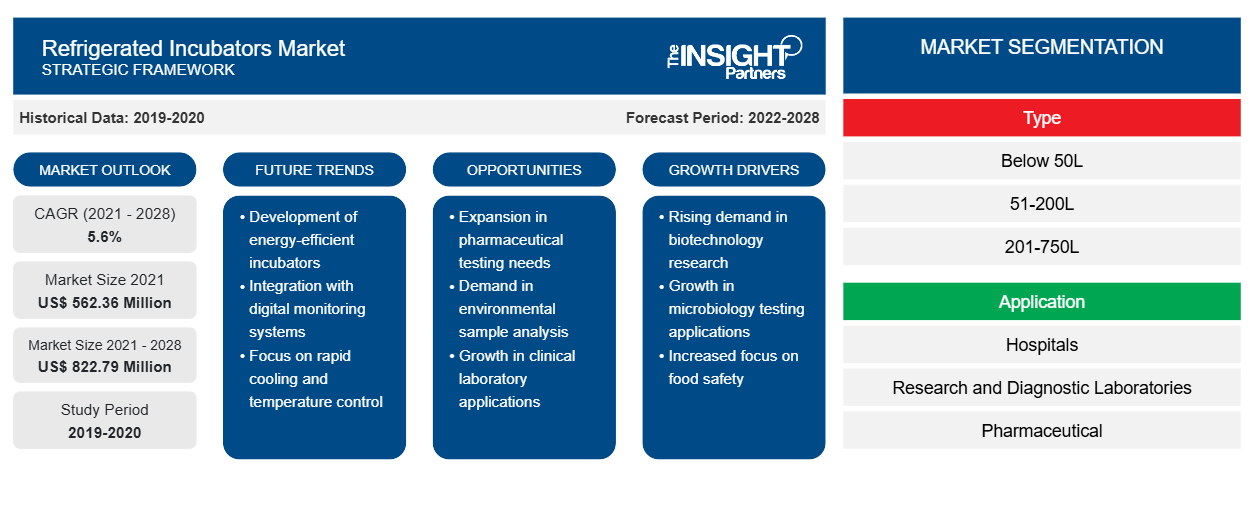Si prevede che il mercato delle incubatrici refrigerate raggiungerà gli 822,79 milioni di dollari entro il 2028, rispetto ai 562,36 milioni di dollari del 2021; si prevede una crescita a un CAGR del 5,6% dal 2021 al 2028.
L'elevata adozione di incubatori refrigerati da parte di centri di ricerca o laboratori guida la crescita del mercato. Nel settore medico, lavorare con i microrganismi svolge un ruolo fondamentale. La produzione e la moltiplicazione efficiente dei microrganismi richiedono una fase di incubazione stabile. Con l'avvento della tecnologia, i ricercatori si sono spostati verso l'utilità di incubatori o apparecchiature basate su tecnologie avanzate che mirano a un consumo efficiente dal punto di vista energetico rispetto ai tradizionali incubatori di raffreddamento. Ad esempio, l'uso di incubatori di raffreddamento presso centri di ricerca, centri farmaceutici e biotecnologici e laboratori è elevato in quanto riduce il consumo di energia e minimizza la distribuzione non uniforme della temperatura. Inoltre, diversi importanti attori della concorrenza, come Binder GmBH , progettano incubatori refrigerati con caratteristiche uniche, come un'unità di compressione-refrigerazione, che garantisce un flusso di temperatura costante. Inoltre, gli incubatori refrigerati funzionano con una particolare tecnologia convenzionale che fornisce una temperatura stabile e continua all'interno della camera dell'incubatrice.
Inoltre, con gli elevati progressi e la crescita nel campo della biologia attraverso l'afflusso di prodotti farmaceutici, zoologia, microbiologia, genetica ed ecologia, la richiesta di incubatori refrigerati basati su tecnologia avanzata è sempre più alta. I principali attori competitivi, come Being Scientific Inc., offrono incubatori refrigerati basati su tecnologia avanzata per facilitare la crescita e lo stoccaggio di campioni biologici. Inoltre, l'offerta di prodotti dell'azienda ha un forte spostamento o attenzione verso la progettazione di incubatori refrigerati basati su tecnologia avanzata che comprendono applicazioni critiche. Questi includono la domanda biologica di ossigeno (BOD), efficace per i test delle acque reflue con elevata applicabilità nei laboratori di microbiologia, nei laboratori di biologia cellulare e nei laboratori farmaceutici che si dimostrano efficaci per lo stoccaggio di farmaci e campioni biologici. Pertanto, le crescenti attività di R&S e i principali attori che contribuiscono al lancio di prodotti innovativi correlati agli incubatori refrigerati si traducono in un'elevata accettazione in tutto il mondo. Tali attività spingono ulteriormente le vendite nel mercato globale degli incubatori refrigerati
Personalizza questo report in base alle tue esigenze
Riceverai la personalizzazione gratuita di qualsiasi report, comprese parti di questo report, o analisi a livello nazionale, pacchetto dati Excel, oltre a usufruire di grandi offerte e sconti per start-up e università
-
Scopri le principali tendenze di mercato in questo rapporto.Questo campione GRATUITO includerà analisi di dati che spaziano dalle tendenze di mercato alle stime e alle previsioni.
La crescente adozione di incubatori refrigerati e l'aumento dei finanziamenti governativi destinati alle attività di R&S offrirebbero opportunità redditizie per il mercato globale degli incubatori refrigerati durante il periodo di previsione. Il rapporto della Public Library of Science ( PLOS ) afferma che negli ultimi anni sono state osservate numerose sfide legate alla lotta contro le malattie infettive emergenti, in particolare la resistenza antimicrobica ( AMR ) e le malattie neglette ( ND ). Ad esempio, il Consultative Expert Working Group ( CEWG ) si concentra sul finanziamento della R&S e il coordinamento presso l'Organizzazione mondiale della sanità (OMS) ha suggerito di cercare alternative legate al finanziamento e all'incentivazione della R&S sia per l'innovazione che per l'accesso alle malattie infettive emergenti. Per i registri, il CEWG e la Lancet Commission hanno annunciato un finanziamento globale per l'assistenza sanitaria di 6 miliardi di dollari all'anno per la resistenza antimicrobica ( AMR ) e 10 miliardi di dollari per le infezioni emergenti. Pertanto, con l'aumento delle attività di R&S mirate alle malattie infettive emergenti e all'AMR , l'adozione di incubatori refrigerati è aumentata drasticamente nel corso degli anni.
Attualmente, i produttori stanno incanalando fondi per attività di ricerca e sviluppo per introdurre prodotti basati su incubatori refrigerati sofisticati ed economici in tutto il mondo. I principali attori della concorrenza, come Thermo Fischer Scientific, hanno annunciato il lancio di nuovi incubatori refrigerati in mercati regionali, come Europa, Asia Pacifico e America Latina. I sistemi sono in grado di trovare ampia applicazione nei settori farmaceutico, delle scienze biologiche, del trattamento delle acque, microbiologico e dei test BOD. Tali fattori sopra menzionati rafforzerebbero la crescita del mercato globale degli incubatori refrigerati nel periodo 2021-2028.
È probabile che il Nord America dominerà il mercato globale degli incubatori refrigerati nel periodo 2021-2028. Gli Stati Uniti detengono la quota di mercato più ampia in questa regione. Secondo il rapporto di Clinical Trials.gov , la New York Stem Cell Foundation ( NYSCF ) conduce ricerche per studiare diverse condizioni e malattie utilizzando cellule staminali e altri tipi di cellule, conducendo ricerche su campioni biologici, eseguendo test genetici e conservando questi campioni per un breve periodo di tempo per un uso futuro. Inoltre, i ricercatori nei laboratori statunitensi stanno creando cellule produttrici di insulina pancreatica per identificare il diabete di tipo 1, le cellule cerebrali e il morbo di Parkinson. Tali fattori supportano fortemente l'adozione di incubatori refrigerati nei laboratori statunitensi. Inoltre, solo negli Stati Uniti, ci sono più di 40.000 laboratori di ricerca individuali situati nei campus universitari coinvolti nel progresso del campo delle scienze biologiche e biomediche. La ricerca comprende ampi campioni biologici da studi clinici e di campo, che rappresentano un enorme valore scientifico e finanziario per ricercatori e organizzazioni, come aziende biotecnologiche/ farmaceutiche , biobanche , istituti di ricerca e università. Si prevede che tali fattori sopra menzionati stimoleranno la crescita del mercato globale degli incubatori refrigerati durante il periodo di previsione.
Approfondimenti sulle applicazioni
In base all'applicazione, il mercato globale degli incubatori refrigerati è segmentato in ospedali, laboratori di ricerca e diagnostica; aziende farmaceutiche, cosmeceutiche e biotecnologiche; istituti di ricerca e accademici; e altri. Si stima che il segmento degli ospedali, dei laboratori di ricerca e diagnostica rappresenti la quota di mercato maggiore nel periodo 2021-2028. Gli ospedali svolgono un ruolo significativo nell'offrire un'ampia gamma di servizi medici ai pazienti affetti da varie malattie. Pertanto, la crescente adozione di incubatori refrigerati negli ospedali è elevata a causa della crescente prevalenza di infezioni croniche e del trattamento migliore di disturbi complessi. Inoltre, nei laboratori di ricerca e diagnostica, vi è una significativa adozione di tali incubatori poiché la conservazione dei campioni richiede diversi tipi di incubatori refrigerati. Pertanto, i fattori sopra menzionati guiderebbero la crescita del mercato globale degli incubatori refrigerati per questo segmento nel periodo 2021-2028.
Le aziende che operano nel mercato globale degli incubatori refrigerati adottano una strategia di innovazione di prodotto per soddisfare le mutevoli esigenze dei clienti in tutto il mondo, il che consente loro anche di mantenere il proprio marchio sul mercato globale.
Approfondimenti regionali sul mercato degli incubatori refrigerati
Le tendenze regionali e i fattori che influenzano il mercato degli incubatori refrigerati durante il periodo di previsione sono stati ampiamente spiegati dagli analisti di Insight Partners. Questa sezione discute anche i segmenti e la geografia del mercato degli incubatori refrigerati in Nord America, Europa, Asia Pacifico, Medio Oriente e Africa e America centrale e meridionale.

- Ottieni i dati specifici regionali per il mercato degli incubatori refrigerati
Ambito del rapporto di mercato degli incubatori refrigerati
| Attributo del report | Dettagli |
|---|---|
| Dimensioni del mercato nel 2021 | 562,36 milioni di dollari USA |
| Dimensioni del mercato entro il 2028 | 822,79 milioni di dollari USA |
| CAGR globale (2021 - 2028) | 5,6% |
| Dati storici | 2019-2020 |
| Periodo di previsione | 2022-2028 |
| Segmenti coperti |
Per tipo
|
| Regioni e Paesi coperti |
America del Nord
|
| Leader di mercato e profili aziendali chiave |
|
Densità degli attori del mercato degli incubatori refrigerati: comprendere il suo impatto sulle dinamiche aziendali
Il mercato degli incubatori refrigerati sta crescendo rapidamente, spinto dalla crescente domanda degli utenti finali dovuta a fattori quali l'evoluzione delle preferenze dei consumatori, i progressi tecnologici e una maggiore consapevolezza dei vantaggi del prodotto. Con l'aumento della domanda, le aziende stanno ampliando le loro offerte, innovando per soddisfare le esigenze dei consumatori e capitalizzando sulle tendenze emergenti, il che alimenta ulteriormente la crescita del mercato.
La densità degli operatori di mercato si riferisce alla distribuzione di aziende o società che operano in un particolare mercato o settore. Indica quanti concorrenti (operatori di mercato) sono presenti in un dato spazio di mercato in relazione alle sue dimensioni o al valore di mercato totale.
Le principali aziende che operano nel mercato degli incubatori refrigerati sono:
- Binder GmbH
- Thermo Fischer Scientific Inc.
- Società di partecipazione PHC
- Eppendorf Italia S.p.A.
- Amerex Instruments, Inc.
Disclaimer : le aziende elencate sopra non sono classificate secondo un ordine particolare.

- Ottieni una panoramica dei principali attori del mercato degli incubatori refrigerati
Mercato globale degli incubatori refrigerati – Segmentazione
In base al tipo, il mercato globale delle incubatrici refrigerate è segmentato in sotto i 50L, 51–200L, 201–750L, 751–1500L e sopra i 1501L. In base all'applicazione, il mercato è segmentato in ospedali, laboratori di ricerca e diagnostica; aziende farmaceutiche, cosmeceutiche e biotecnologiche; istituti di ricerca e accademici; e altri. In base alla geografia, il mercato globale delle incubatrici refrigerate è principalmente segmentato in Nord America, Europa, Asia Pacifico, Medio Oriente e Africa (MEA) e Sud e Centro America. Il mercato in Nord America è ulteriormente segmentato in Stati Uniti, Canada e Messico. Il mercato europeo delle incubatrici refrigerate è sottosegmentato in Francia, Germania, Regno Unito, Spagna, Italia e resto d'Europa. Il mercato in Asia Pacifico è sottosegmentato in Cina, India, Giappone, Australia, Corea del Sud e resto dell'APAC. Il mercato delle incubatrici refrigerate nell'area MEA è ulteriormente segmentato in Arabia Saudita, Emirati Arabi Uniti, Sudafrica e resto dell'area MEA. Il mercato in America meridionale e centrale è sottosegmentato in Brasile, Argentina e resto dell'America meridionale e centrale.
Profili aziendali
- Binder GmbH
- Thermo Fischer Scientific Inc.
- Società di partecipazione PHC
- Eppendorf Italia S.p.A.
- Amerex Instruments, Inc.
- Azienda manifatturiera Sheldon, Inc.
- Società anonima LEEC Ltd.
- Memmert GmbH + Co. KG
- Punto di riferimento scientifico
- Società per azioni Gilson Inc.
- Analisi storica (2 anni), anno base, previsione (7 anni) con CAGR
- Analisi PEST e SWOT
- Valore/volume delle dimensioni del mercato - Globale, Regionale, Nazionale
- Industria e panorama competitivo
- Set di dati Excel
Report recenti
Testimonianze
Motivo dell'acquisto
- Processo decisionale informato
- Comprensione delle dinamiche di mercato
- Analisi competitiva
- Analisi dei clienti
- Previsioni di mercato
- Mitigazione del rischio
- Pianificazione strategica
- Giustificazione degli investimenti
- Identificazione dei mercati emergenti
- Miglioramento delle strategie di marketing
- Aumento dell'efficienza operativa
- Allineamento alle tendenze normative























 Ottieni un campione gratuito per - Mercato degli incubatori refrigerati
Ottieni un campione gratuito per - Mercato degli incubatori refrigerati